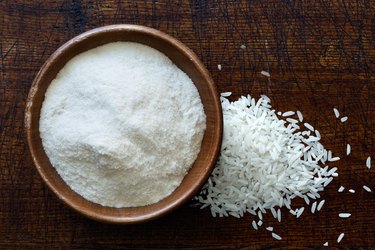
Beyond Celiac notes that rice flour can be used in combination with other gluten-free flours — like sorghum, oat and tapioca — and a gum such as xanthan — in place of all-purpose flour in baking. It can be partly swapped for all-purpose flour in some recipes but can't be used as a 1:1 substitute.
Read more: 10 Gluten-Free Dessert Recipes From Coconut Milk Panna Cotta to Sweet Potato Pudding
Naturally gluten-free white or brown rice flour can be used in smaller amounts in cooking, instead of all-purpose flour, such as a thickener in sauces or stews. It is also a main ingredient in rice noodles and some pancakes, such as South Indian appams.
Video of the Day
Video of the Day
Baking With Rice Flour
All types of rice flour are gluten-free. It's important to remember that there is no gluten-free flour or starch that behaves exactly like wheat flour — which is what all-purpose flour is made from.
As the Celiac Disease Foundation explains, gluten is a protein found in certain types of grains such as wheat and rye. Gluten helps foods maintain their shape, acting as a sort of glue that holds foods together.
When baking with rice flour, you should expect results to be wholly different from when you bake with gluten-containing all-purpose flour, says the University of Missouri Extension.
For one thing, rice flour doesn't absorb liquid and fat like wheat flour. This will cause cookies to spread and cakes to be soft and greasy if you do a straight substitution for all-purpose flour. Rice flour, like most gluten-free flours, is best used in a mix with other flours.
Read more: 15 Unexpected Foods That Contain Gluten
As you bake with rice flour, you may find that some recipes are better served by different combinations — cookies may benefit from a mix of brown rice flour, almond flour and potato starch, whereas cakes may taste better with a blend comprising sweet rice flour, millet flour and tapioca.
Types of Rice Flour
White rice flour has a neutral flavor and smooth texture, with a long shelf life. It's not ideal for use in recipes with little liquid and a high fat content, like cookies and muffins and is best used as 30 to 60 percent of a flour mix.
Brown rice flour has a mild flavor and texture and gives baked goods a slightly browner look. It's best used as 30 to 60 percent of a flour mix.
Sweet rice flour (or glutinous rice flour) has natural elasticity that works well for making rice noodles and combining more easily with fats than the other rice flours. Despite its name, this flour isn't sweet and doesn't contain gluten.
Sweet white rice flour is higher in starch and is made from the rice used to make "sticky rice" in Thai restaurants. It works well as a thickener for soups and sauces and for making rice noodles and wrappers. It's best used as up to 40 percent of a flour mix.
How to Make Rice Flour
As you experiment with using rice flour, determine which is appropriate for each baking or cooking task and try making your own.
Choose white or brown rice to make flour; brown rice is better for baking because it has a slightly sweeter, nuttier taste, but it will not last as long in your pantry. Brown rice is also more nutritious because it has not been processed as much as white rice, and it contains more protein.
Read more: Nutritional Values of White Rice Vs. Brown Rice
One cup of rice will yield about 1 1/2 cups of rice flour. The rice should be dry and uncooked before you blend it:
- Blend the rice. Place 1 to 2 cups of rice in your blender at a time. Cover the blender, turn it to the highest setting and grind the rice until it's a fine powder without any chunks of rice remaining. Rice flour works best when it's very fine.
- Transfer the flour to an airtight container and cover it tightly. Rice flour may be stored in a dark, cool place in the pantry or in the fridge or freezer.